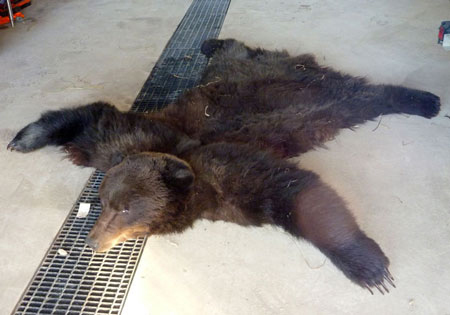Trace Evidence Links Hunter to Grizzly Bear Poaching
Government of Alberta, Fish & Wildlife Enforcement Branch, Special Investigations and Forensic Services Section
Publication Date: 2014
Introduction
In Alberta, grizzly bears are listed as a threatened species, and the hunting of grizzly bears was suspended in 2006. Poaching of a grizzly bear can lead to a significant fine and substantial jail time. In addition to hunting grizzly bears, it is illegal to be in possession of parts of illegally killed bears, and it is illegal to abandon a grizzly bear hide.
The Alberta Fish & Wildlife Enforcement Branch investigates thousands of crimes involving wildlife every year. Within the branch, the Forensic Unit is a fully functioning forensic DNA laboratory that has developed genotyping tests for nine species. One of those species is grizzly bear. Applying the same technology as in a human forensic DNA laboratory, biological evidence can be used to link a suspect to a crime.
Criminal Investigation
In October of 2011, a grizzly bear (Ursus arctos) hide, with the head and front legs still attached (Figure 1) was found abandoned in a ditch outside the community of Stony Plain, which is about 60km from Edmonton, Alberta, Canada.
 Figure 1. Abandoned grizzly bear hide. Photo taken by investigating officer.
Figure 1. Abandoned grizzly bear hide. Photo taken by investigating officer. Since there was no information connected to the abandoned carcass, the Fish & Wildlife Enforcement Branch used local media to appeal to the public in the hopes of gaining information. In November of 2011 a witness came forward with information relating to the investigation, and a suspect was identified. The information was sufficient to obtain a search warrant for the suspect’s truck and garage. Biological evidence, including a few possible bear hairs, was recovered during the search.
This search also led to the discovery of a cell phone, which linked two more suspects (the suspected shooter and her brother) to the bear. A search warrant was obtained for the suspected shooter’s residence.
Many items were seized from the suspected shooter’s residence, including a computer containing a digital photo of the suspected shooter with a large, dead bear that resembled the abandoned hide. The GPS information associated with the digital photo directed the investigators towards a potential kill site.
The following spring, many months after the hide was found, a Fish and Wildlife Officer, along with his family dog, travelled to the suspected kill site using the GPS information from the digital photo of the suspected shooter with the dead bear. Due to the harsh winter conditions and scavenging of the carcass, only a single rib bone and some hairs were recovered from the site.
DNA Analysis
Two extraction methods were employed in this case:
1) Samples were incubated at room temperature for a minimum of 1 hour, then extracted using the gDNA2 protocol on the KingFisher® mL purification system in conjunction with the Toyobo MagExtractor nucleic acid purification kit.
2) Samples were incubated on a Thermomixer® at 56°C and 900rpm for a minimum of 1 hour, then extracted using the QIAcube® Investigator Kit Purification protocol in conjunction with the QIAGEN DNeasy® Blood & Tissue Kit.
The Forensic Unit uses method 1 for tissue, antler and stains on larger substrates, and this method was used to extract DNA from the tissue sample off of the abandoned hide. Method 2 is used for hairs, bone, and trace or challenged samples. DNA from the hairs found on the first suspect’s truck and the rib bone found at the possible kill site was extracted using method 2.
Amplification of the 12 microsatellite loci and a sex-typing locus used in the individual identification of bears was performed in 25µl reactions using the QIAGEN Multiplex PCR Master Mix and an STR multiplex developed in house. Capillary electrophoresis was performed on the ABI PRISM® 310 Genetic Analyzer, and genotypes were assigned using SoftGenetics GeneMarker® software.
Results
Full DNA typing profiles (all 13 loci) were developed from the hair collected from the initial suspect’s truck, the rib bone from the potential kill site and the abandoned hide. The DNA typing profiles from all three samples matched at all loci. The random match probability calculated from the Alberta grizzly bear population is 1 in 22 trillion.
None of the biological evidence recovered from the suspected shooter’s residence linked her to the offense. The hairs found at the potential kill site gave partial profiles that also matched the abandoned hide.
Outcome
In July of 2012, the initial suspect pled guilty to unlawful possession of a grizzly bear and wastage of a grizzly bear. He was fined $11,500 and received a three-year hunting suspension. In December of 2012, the shooter pled guilty to hunting during a closed season and unlawful possession of a grizzly bear. She received $15,000 in fines and a six-year hunting suspension. The shooter’s brother pled guilty to unlawful possession of a grizzly bear and received $4,000 in fines and a three-year hunting suspension. Since all three parties pled guilty, no testimony was required from forensic unit staff or investigators.
How to Cite This Article
Scientific Style and Format, 7th edition, 2006
Monderman, L., Packer, T. and Jobin, R. Trace Evidence Links Hunter to Grizzly Bear Poaching. [Internet] 2014. [cited: year, month, date]. Available from: https://www.promega.com/resources/profiles-in-dna/2014/trace-evidence-links-hunter-to-grizzly-bear-poaching/
American Medical Association, Manual of Style, 10th edition, 2007
Monderman, L., Packer, T. and Jobin, R. Trace Evidence Links Hunter to Grizzly Bear Poaching. Promega Corporation Web site. https://www.promega.com/resources/profiles-in-dna/2014/trace-evidence-links-hunter-to-grizzly-bear-poaching/ Updated 2014. Accessed Month Day, Year.
Contribution of an article to Profiles in DNA does not constitute an endorsement of Promega products.
ABI PRISM is a registered trademark of Applied Biosystems. DNeasy and QIAcube are registered trademarks of Qiagen GmbH Corporation. GeneMarker is a registered trademark of SoftGenetics Corporation. KingFisher is a registered trademark of Thermo Electron Corporation. Thermomixer is a registered trademark of Eppendorf AG.